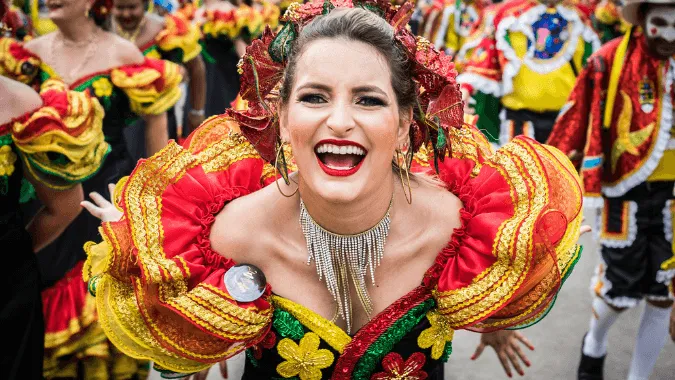Street Carnival in Rio de Janeiro
The street carnival in Rio de Janeiro dates back to the mid 19th century, originating from the traditional festivities in Europe, but acquiring a tropical, Brazilian twist. Groups of people, some organized some not, would join in the street during the carnaval to have fun, play instruments, sing and dance.
History of the Street Carnival in Rio de Janeiro
At the beginning of the 20th century, some of them became better organized, with composers and parades. They became the first Samba Schools, resulting in the carnival we see today. However, some remained simply as streets of happy people, maintaining the tradition of street carnival in Rio de Janeiro. Nowadays, Rio de Janeiro is swarmed by foliões (carnival revellers) from all around the world throughout February and up until just after the carnival actually takes place. Well organized by the city officials, with portaloos, police surveillance and with reduced traffic, today the street carnival in Rio de Janeiro is a great way to have a blast in the Cidade Maravilhosa.Below are the top 3 parades that you shouldn't miss if you're in Rio for the carnaval:
1. Cordão do Bola Preta: 96 years of carnival excellency
When: Saturday, 1st of March, at 9AM Where: Rio Branco Ave., downtown Rio de Janeiro [caption id="attachment_7874" align="alignnone" width="702"] Street Carnival in Rio de Janeiro - Cordão do Bola Preta[/caption] The Cordão da Bola Preta (or simply "Bola Preta", the Black Ball), founded in 1918, is the oldest street carnival in Rio de Janeiro and one of the oldest of the whole country. It’s a true relic of the carnival groups from the early 20th century in Rio. It’s birth place is Rua da Glória 88, where the first parade took place on December 13th 1918. The Bola Preta traditionally takes place every Saturday of carnival at Rio Branco Ave., downtown Rio de Janeiro. The parade starts at about 9AM and goes until 2PM. The traditional colors of the group are black and white, and the official outfit is white clothing with black spots. Every year, tens of thousands of people get together to celebrate the carnival, honouring the traditions and singing all the golden oldies of street carnival sambas of Rio de Janeiro.
Street Carnival in Rio de Janeiro - Cordão do Bola Preta[/caption] The Cordão da Bola Preta (or simply "Bola Preta", the Black Ball), founded in 1918, is the oldest street carnival in Rio de Janeiro and one of the oldest of the whole country. It’s a true relic of the carnival groups from the early 20th century in Rio. It’s birth place is Rua da Glória 88, where the first parade took place on December 13th 1918. The Bola Preta traditionally takes place every Saturday of carnival at Rio Branco Ave., downtown Rio de Janeiro. The parade starts at about 9AM and goes until 2PM. The traditional colors of the group are black and white, and the official outfit is white clothing with black spots. Every year, tens of thousands of people get together to celebrate the carnival, honouring the traditions and singing all the golden oldies of street carnival sambas of Rio de Janeiro. Simpatia é Quase Amor: Carnival irreverence at its best
When: Sunday, 2nd of March, at 3PM Where: General Osório Sq., in Ipanema
[caption id="attachment_7876" align="alignnone" width="702"] Street Carnival in Rio de Janeiro - Simpatia é Quase Amor / source[/caption] The Simpatia é Quase Amor (or simply “Simpatia”, the Sympathy is Almost Love) is a street carnival in Rio de Janeiro that was started in 1984, in the middle of the popular claims for free votes for every electoral position at the end of the last dictatorship in Brazil. It was born and raised in Ipanema and is very irreverent in its sambas and in the types of costume its followers wear. Its official colours are yellow and purple, an homage to a famous anti-hangover medicine in Brazil. The group parades every Sunday of carnival, at General Osório Sq., starting at 3PM.
Street Carnival in Rio de Janeiro - Simpatia é Quase Amor / source[/caption] The Simpatia é Quase Amor (or simply “Simpatia”, the Sympathy is Almost Love) is a street carnival in Rio de Janeiro that was started in 1984, in the middle of the popular claims for free votes for every electoral position at the end of the last dictatorship in Brazil. It was born and raised in Ipanema and is very irreverent in its sambas and in the types of costume its followers wear. Its official colours are yellow and purple, an homage to a famous anti-hangover medicine in Brazil. The group parades every Sunday of carnival, at General Osório Sq., starting at 3PM. Monobloco: New traditions brings new sambas
When: Sunday, 9th of March, at 9AM Where: Rio Branco Ave., downtown Rio de Janeiro Formed by samba school members, the Monobloco group was born in 2000 as a percussion workshop. At the end of the first year, the group paraded in the streets and officially became a street carnival in Rio de Janeiro. They differentiate from other groups with their use of samba school instruments, by playing other sorts of rhythms beyond the samba, such as marchinha, coco, funk, xote, ciranda and charm. [caption id="attachment_7878" align="alignnone" width="317"] Street Carnival in Rio de Janeiro - Monobloco / source[/caption] Every year, on the Sunday after the Carnaval, the group parades with all its members through the streets. While it begun in the streets of Ipanema and Leblon, their followers grew so much in quantity that the City Hall asked them to go to Copacabana, and later, downtown Rio de Janeiro. Nowadays, the group parades at Rio Branco Ave, and it’s the second largest group of street carnival in Rio de Janeiro (after the Cordão do Bola Preta). It starts at 9AM and there’s no dress code.
Street Carnival in Rio de Janeiro - Monobloco / source[/caption] Every year, on the Sunday after the Carnaval, the group parades with all its members through the streets. While it begun in the streets of Ipanema and Leblon, their followers grew so much in quantity that the City Hall asked them to go to Copacabana, and later, downtown Rio de Janeiro. Nowadays, the group parades at Rio Branco Ave, and it’s the second largest group of street carnival in Rio de Janeiro (after the Cordão do Bola Preta). It starts at 9AM and there’s no dress code. As well as the above groups, there are a hundreds of others that are equally popular for their music and dancing across the streets of Rio de Janeiro. Some are smaller, for children only, for gays & lesbians, some take place in the morning or all night long...now it's just down to you to choose your favourite and hit the streets to samba!
Here you can find the schedule for all the street carnivals in Rio de Janeiro. Visit our website for more information, or to book tours and activities in Rio.By: Pedro Rocha - Community Manager
-
Exciting 4x4 route: São Luís and FortalezafromUS$1,014
-
Vila Gale Mares Resort All InclusivefromUS$100
-
Ecotourism in Chapada DiamantinafromUS$672
-
All inclusive Vila Gelé Cumbuco ResortfromUS$999
-
Full Day Cafayate Tour from SaltafromUS$68
-
Transfer Aeroparque - Buenos AiresfromUS$46
-
-
Transfer Ezeiza - AeroparquefromUS$91
-
-
Excursion to El Chaltén from El CalafatefromUS$153
-
-
-
-
-
-
-
-
-
-
-



